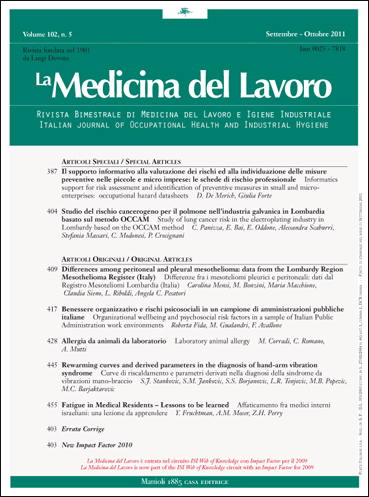Studio del rischio cancerogeno per il polmone nell’industria galvanica in Lombardia basato sul metodo OCCAM / Study of lung cancer risk in the electroplating industry in Lombardy based on the OCCAM method
Contenuto principale dell'articolo
Keywords
Abstract
Summary
«Study of lung cancer risk in the electroplating industry in Lombardy based on the OCCAM method». Background: The OCCAM method consists of case-control studies aimed at estimating occupational risks by cancer site, by area and by economic sector, using available archives to identify cases and controls; for exposure definition each subject is assigned to the category code of the economic sector or company where he/she worked the longest, obtained by automatic link with the Social Security Institute (INPS) files. The reference category (unexposed) consists of service industry workers. The economic sector is given by the ATECO category that INPS assigns to each firm. Objectives: In the Lombardy Region, lung cancer risk evaluated for the “metal treatment” industry as a whole was 1.32 (90% CI 1.33-3.10, 67 cases) for males and 1.33 (90% CI 0.51-3.59, 10 cases) for females. The aim of the study was to estimate lung cancer risk among metal electroplating workers only. Methods: The metal electroplating firms were identified according to the detailed description of production, data which was also contained in INPS files, instead of using the “metal treatment” ATECO code. Lung cancer risk was evaluated using 2001-2008 incident cases identified from hospital discharge records of residents in the Lombardy Region. Controls were a sample from National Health Service files. Results: For the group of firms identified as metal electroplating industries the risk was 2.03 (90% CI 1.69-8.32, 18 cases) for males and 3.75 (90% CI 1.38-9.03, 4 cases) for females. Conclusions: Focusing on the true electroplating firms increased the risk estimates. Even though these risk were due to past exposures, case histories and recent acute effects indicate that, at least in some factories, a carcinogenic hazard still exists.
«Study of lung cancer risk in the electroplating industry in Lombardy based on the OCCAM method». Background: The OCCAM method consists of case-control studies aimed at estimating occupational risks by cancer site, by area and by economic sector, using available archives to identify cases and controls; for exposure definition each subject is assigned to the category code of the economic sector or company where he/she worked the longest, obtained by automatic link with the Social Security Institute (INPS) files. The reference category (unexposed) consists of service industry workers. The economic sector is given by the ATECO category that INPS assigns to each firm. Objectives: In the Lombardy Region, lung cancer risk evaluated for the “metal treatment” industry as a whole was 1.32 (90% CI 1.33-3.10, 67 cases) for males and 1.33 (90% CI 0.51-3.59, 10 cases) for females. The aim of the study was to estimate lung cancer risk among metal electroplating workers only. Methods: The metal electroplating firms were identified according to the detailed description of production, data which was also contained in INPS files, instead of using the “metal treatment” ATECO code. Lung cancer risk was evaluated using 2001-2008 incident cases identified from hospital discharge records of residents in the Lombardy Region. Controls were a sample from National Health Service files. Results: For the group of firms identified as metal electroplating industries the risk was 2.03 (90% CI 1.69-8.32, 18 cases) for males and 3.75 (90% CI 1.38-9.03, 4 cases) for females. Conclusions: Focusing on the true electroplating firms increased the risk estimates. Even though these risk were due to past exposures, case histories and recent acute effects indicate that, at least in some factories, a carcinogenic hazard still exists.






